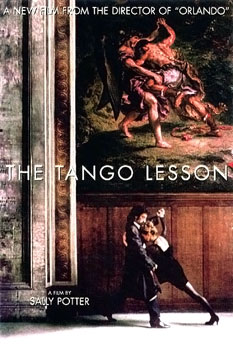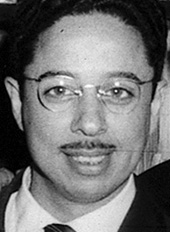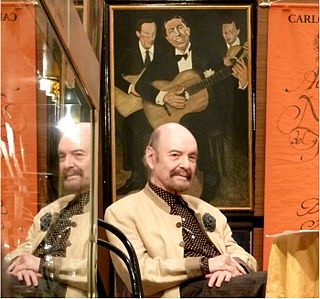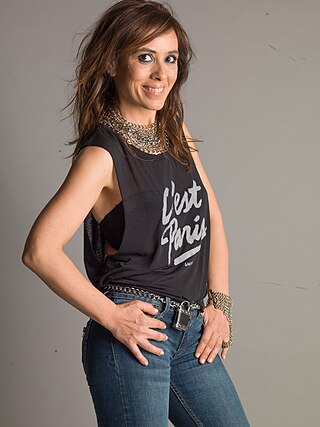Related Research Articles

Astor Pantaleón Piazzolla was an Argentine tango composer, bandoneon player, and arranger. His works revolutionized the traditional tango into a new style termed nuevo tango, incorporating elements from jazz and classical music. A virtuoso bandoneonist, he regularly performed his own compositions with a variety of ensembles. In 1992, American music critic Stephen Holden described Piazzolla as "the world's foremost composer of Tango music".

The Tango Lesson is a 1997 drama film written and directed by Sally Potter. It is a semi-autobiographical film starring Potter and Pablo Verón, about Argentinian Tango.

Carlos Moscardini is an Argentine composer and guitarist. He is professor of guitar at the Gilardo Gilardi Conservatory of Music and Manuel de Falla Conservatory of Music in Buenos Aires.
Octavio Brunetti was a pianist, arranger and composer from Argentina. He was best known for his participation in the album Te amo tango by Raul Jaurena, which won the Latin Grammy Award for Best Tango Album in 2007, and was one of the most sought after tango pianists.

Horacio Lavandera is an Argentine pianist, currently residing in Madrid, Spain. As its youngest competitor at the age of sixteen, he won the International Piano Competition Umberto Micheli, held at the Giuseppe Verdi Conservatoire and in Teatro alla Scala in Milan. He has been invited to perform as a soloist with prestigious orchestras, as well as to offer recitals in America, Europe, and Asia.

Horacio Adolfo Salgán was an Argentine tango musician. He was born in Buenos Aires to an established Afro-Argentine family. Some of Salgán's most well-known compositions include Del 1 al 5 (1944), A Don Agustín Bardi (1947), Entre tango y tango (1953), Grillito, La llamo silbando, Cortada de San Ignacio, A fuego lento, and Aquellos tangos camperos. He turned 100 in June 2016 and died two months later on August 19, 2016.
Ignacio Varchausky is a double bass player, music producer and the founder of Orquesta El Arranque (1996). He is also the creator and artistic director of Orquesta Escuela de Tango Emilio Balcarce.
Founded in 2002 by its artistic director Ignacio Varchausky, TangoVia Buenos Aires is a non-profit organization for progressive arts - focused on preservation but dedicated to creation - that brings together artists, researchers, producers and cultural institutions for the preservation, development, and promotion of the art of tango in Buenos Aires and around the world. Since TangoVia Buenos Aires understands tango as a constantly evolving living art form, it promotes all of its formats as contemporary and alive.
Orquesta El Arranque is an Argentine tango orchestra formed in Buenos Aires in 1996.
Ricardo Roberto Francia was an Argentine musician, cellist, and music arranger.

Leopoldo Federico was an Argentine bandoneon player, arranger, director and composer.

Horacio Arturo Ferrer Ezcurra was a Uruguayan-Argentine poet, broadcaster, reciter and tango lyricist. He is particularly well known for having composed the lyrics for tangos by Astor Piazzolla, such as Balada para un loco and Chiquilín de Bachín.

The Octeto Buenos Aires was a legendary tango group formed in 1955 by the Argentine bandoneon player Astor Piazzolla. In 1958 the Octeto was disbanded and Piazzolla returned to New York City with his family where he struggled to make a living as a musician and arranger in the next stage of his career that would prove to be so ground-breaking in the history of tango.
Enrique Mario Francini was an Argentine tango orchestra director, composer and violinist who played in various tango ensembles including the Orquesta Francini-Pontier and Ástor Piazzolla's Octeto Buenos Aires.
Enrique Kicho Díaz was an Argentine double bass tango musician who played in various ensembles including Aníbal Troilo’s orquesta típica, Astor Piazzolla’s first Quinteto and Conjunto 9 and finally Sexteto Mayor.
Mario Parmisano, is an Argentinian jazz pianist. He is recognized on the international scene for his work with guitarist Al Di Meola and for his Tango Jazz Trio, performing a unique interpretation about the Music of the Great Tango Master Astor Piazzolla.
Rodolfo Miguel Montironi is an Argentine bandoneonist, conductor, composer and arranger who has been involved in many tango orchestras in addition to his own.
Simón Bajour also Szymsia Bajour was a Jewish Polish-Argentine violinist who was known for both his popular and classical repertoires.

Gabriela Edith Pochinki is a singer of Opera and popular music. She was born in Buenos Aires, Argentina, and has begun her career when she was a child. She has been awarded prizes at major Opera competitions, including "Best Female Opera Singer" at the Sanremo Festival and "Best Singer In The World" at the 3º Festival della Lirica of the Sanremo Musica Festival, both in Italy. She got the second prize at the Pavarotti Competition, where she met Luciano Pavarotti, who stated at the time: "The quality of Gabriela’s voice is stunningly beautiful".

Chola Luna was an Argentine tango singer, who flourished during the 1930s through 1950s. From 1955, she was persecuted for her political ideas during the self-appointed dictatorship of the Revolución Libertadora which ousted in a bloody Coup d'état the democratic elected government of Juan D. Peron (1946-1955). Many performers had to stop their profession, including Luna, and others, persecuted and blacklisted for their political beliefs.
References
- ↑ http://www.tangodata.gov.ar/ingles/e_cd_tangovia.htm%5B%5D
- ↑ "Página/12 :: Espectaculos".
- ↑ "Recensione: Buenos Aires Tango". Archived from the original on 2010-06-14. Retrieved 2009-06-05.
- ↑ "Auditorium Parco della Musica".
- ↑ "Auditorium Parco della Musica".
- ↑ "El Tangauta - el mundo del tango / The world of tango". Archived from the original on 2011-07-10. Retrieved 2009-06-05.